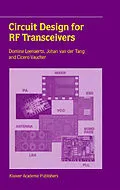Circuit Design for RF Transceivers covers key building blocks which are needed to make an integrated transceiver for wireless and cellular applications, that is low-noise amplifiers, mixers, voltage controlled oscillators, RF power amplifiers and phase-locked loop systems. Starting from detailed RF concepts and specifications, the authors discuss the circuits in detail and provide solutions to many design problems. The circuits are implemented in a wide range of modern technology processes. Production requirements are taken into account, and measurement results are presented and discussed. Several of the presented circuits are used in IC products. The text also includes several RF technologies (for example double-poly, Silicon-on-Anything, SiGe-bipolar, RF-CMOS, etc.) and microwave design techniques, such as transmission line concepts. In addition, the problem of connecting the RF signals on-chip to the PCB and to the antenna will be discussed, including the influence of the package, ESD and bond pads. The contents of Circuit Design for RF Transceivers 2nd edition are based on research activities carried out at Philips Research. Many internal and external publications contributed to make the presented material state-of-the-art. The book is written for people who have a basic knowledge of analogue IC design. The second edition of this successful 2001 RF Circuit Design book has been updated, latest technology reviews have been added as well as several actual case studies. Due to the authors being active in industry as well as academia, this should prove to be an essential guide on RF Transceiver Design for students and engineers.
Autorentext
Dr. Domine Leenaerts is head of the RF Design group at Philips Research in Eindhoven
Klappentext
Applicable for bookstore catalogue
Inhalt
1. RF Design: Concepts and Technology 1.1 RF Specifications 1.1.1 Gain 1.1.2 Noise 1.1.3 Non-Linearity 1.1.4 Sensitivity 1.2 RF Device technology 1.2.1 Characterization and Modeling, Modeling, Cut-off Frequency, Maximum Oscillation Frequency, Input Limited Frequency, Output Limited Frequency, Maximum Available Bandwidth 1.2.2 Technology Choice, Double Poly Devices, Silicon-on-Anything, Comparison, SiGe Bipolar Technology, RF CMOS (updated for newer processes) 1.3 Passives 1.3.1 Resistors 1.3.2 Capacitors (updated for different layouts) 1.3.3 Planar Monolithic Inductors (updated as relation to newer processes) References (updated) 2. Antennas, Interface and substrate 2.1 Antennas 2.2 Bond wires 2.3 Transmission Lines 2.3.1 General Theory 2.3.2 Impedance Matching using Transmission Lines 2.3.3 Microstrip Lines and coplanar Lines 2.4 Bond Pads and ESD Devices 2.4.1 Bond Pads 2.4.2 ESD Devices, ggNMOST ESD Device, pn and np-diode ESD Device (updated for newer processes and detailed scaling effects) 2.5 Substrate 2.5.1 Substrate bounces 2.5.2 Design Techniques to Reduce the substrate bounce References (updated) 3. Low Noise Amplifiers 3.1 Specifications 3.2 Bipolar LNA designs 3.2.1 DCS applications in SOA, Design of the LNA, Measurements 3.2.2 Broadband LNA (new) 3.3 CMOS LNA Design 3.3.1 Single Transistor LNA, Design Steps, Simulation and Measurements 3.3.2 Classical LNA Design, The Design, Measurement Results 3.3.3 Broadband LNA (new) 3.4 Evaluation References (updated) 4. Mixers 4.1 Specification 4.2 Bipolar Mixer Design 4.3 CMOS mixers 4.3.1 Active CMOS mixer 4.3.2 Passive CMOS mixer, 1/f-Noise in mixer transistors, 1/f-Noise due to IF amplifier, 1/f-noise due to Switched-Capacitor Behavior 4.3.3 Concluding remarks References (Updated) 5. Case study Receiver front-ends (new) 5.1 Bluetooth (new) 5.2 IEEE 802.11a Standard (new) 6. RF Power Amplifier 6.1 Specification 6.1.1 Efficiency 6.1.2 Generic Amplifier Classes 6.1.3 Heating 6.1.4 Linearity 6.1.5 Ruggedness 6.2 Bipolar PA design 6.3 CMOS PA Design 6.4 Linearization Principles 6.4.1 Predistortion Technique 6.4.2 Phase-Correcting feedback 6.4.3 Envelope Elimination and Restoration (EER) 6.4.4 Cartesian Feedback 6.5 Case study: Bluetooth PA (new) References (updated) Note: Oscillator chapter: errors removed and updated throughout, sub-section headings probably quite similar but to be defined 7. Oscillators 7.1 Introduction 7.2 Specifications 7.3 LC oscillator 7.4 Ring oscillators 7.5 Phase noise modelling and simulation (new) 7.6 Typical oscillator performance (new) 7.7 Oscillator case studies (new), Wide range oscillators for mobile applications, Oscillators for ultra low-power wireless links, 10GHz CMOS VCO for WLAN, 10GHz QuBIC VCO for Satellite References (updated) 8. Frequency Synthesizers 8.1 Introduction 8.2 Integer-N PLL Architecture 8.3 Tuning System Specifications 8.3.1 Tuning Range 8.3.2
